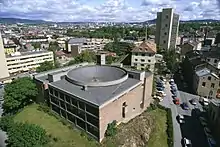Nils Slaatto
Nils Slaatto (June 22, 1922 – March 16, 2001) was for more than two decades one of Norway's most prominent and influential architects, having a strong and distinctive impression on Norwegian architecture. Slaatto cooperated with Kjell Lund in an architectural firm partnership for many years.[1][2]
Nils Slaatto | |
|---|---|
| Born | 22 June 1923 |
| Died | 16 March 2001 |
| Nationality | Norwegian |
| Occupation | Architect |
| Practice | Lund+Slaatto Arkitekter |
| Buildings | Asker Town Hall The Ål cabin |



Background
Nils Slaatto was born in the town of Lillehammer in Oppland, Norway. His father, Oddmund Eindride Slaatto, was a functionalist architect in Oslo in the years between the two world wars. His mother, Anine Wollebæk, was also an architect, graduating from the University of Technology, but never practised.
During 1938-39, Nils Slaatto took carpentry at the Technical School in Oslo before he enrolled in the Norwegian Institute of Technology, Faculty of Architecture, where he graduated in 1947. The post-war period offered numerous tasks; the most demanding was the rebuilding of northern Norway, where Slaatto participated in the reconstruction of Finnmark as district architect in Vadsø and Tana from 1948 to 1950. Large parts of the area suffered major damage during the war because of the Germans' use of the scorched-earth tactic.[3]
Career
In 1957, Nils Slaatto and Kjell Lund, a fellow graduate from the Norwegian Institute of Technology, were invited to take part in a limited competition for an extension to the Akershus County Agricultural College at Hvam. In 1958, after winning the competition, they were able to start their architectural firm Lund & Slaatto Arkitekter AS, a partnership that lasted for three decades. As youngsters, Slaatto and fellow Lillehammer native, Lund, had both wandered around Maihaugen, an open-air museum consisting of many types of old wooden farm buildings They were influenced by this Norwegian wood architecture, adapting age-old techniques to modern production demands. An example is the "Ål cabin" in the Hallingdal Valley, designed in cooperation with Jon Haug. [4][5]
The architectural firm of Lund & Slaatto was awarded the Houen Foundation Award for three of their designs: St. Hallvard's Church and Monastery at Enerhauggata in Oslo, DNV GL headquarters at Høvik in Bærum, and St. Magnus Catholic Church at Romeriksgata in Lillestrøm.[6]
Personal life
In 1949, Slaatto married Margit Bleken of Trondheim, the sister of the famous Norwegian artist Håkon Bleken. When they moved to Oslo, Slaatto started as the leader of the Farmers' Architectural Office.
Selected works
- 1964 - Asker Town Hall in Akershus
- 1966 - St. Hallvard's Church and Monastery in Oslo
- 1971 - Det Norske Studentersamfund - Chateau Neuf in Oslo
- 1975 - St. Hallvard's Church and Monastery at Enerhauggata in Oslo
- 1988- DNV GL headquarters at Høvik in Bærum
- 1991 - St. Magnus Catholic Church at Romeriksgata in Lillestrøm
Achievements
- 1962–63 Vice Chairman Oslo Architects' Association
- 1968–70 Vice-President National Federation of Norwegian Architects
- 1965–70 Member of editorial staff Bonytt
- 1968–70 Member of the board of the national Federation of Norwegian Applied Art
- 1965–68 Lecturer at the School of Architecture in Oslo
- 1965–68 Lecturer at the Faculty of Architecture, Norwegian University of Technology
- External examiner, lecturer and consultant for new appointments at the Architectural College
- Member of the jury for Norwegian and Scandinavian architecture competitions
References
- Ulf Grønvold. "Nils Slaatto". Norsk biografisk leksikon. Retrieved 20 October 2009.
- Henriksen, Petter (ed.). "Kjell Lund". Store norske leksikon (in Norwegian). Oslo: Kunnskapsforlaget. Retrieved 7 February 2010.
- Elisabeth Seip. "Nils Slaatto". Norsk kunstnerleksikon. Retrieved 1 September 2017.
- Bjørn Cappelen. "Lund & Slaatto Arkitekter AS". Store norske leksikon. Retrieved 1 September 2017.
- "Firmaets Historie". Lund+Slaatto Arkitekter AS. Retrieved 1 September 2017.
- "Lund & Slaatto". Houens Fonds Diplom. Retrieved 1 September 2017.
Sources
- Grønvold, Ulf (1988) Lund & Slaatto (Universitetsforlaget (1988) ISBN 82-00-02633-7
- Moe, Ingvild Simers (2006) Eidsvolls plass og Studenterlunden En studie av byrommets funksjonelle, estetiske og symbolske kvaliteter med utgangspunkt i Lund og Slaattos engasjement på 1970- og 80-tallet (Masters Theses in Art History at University of Oslo)
External links
- Lund+Slaatto Arkitekter Official website(Norwegian)